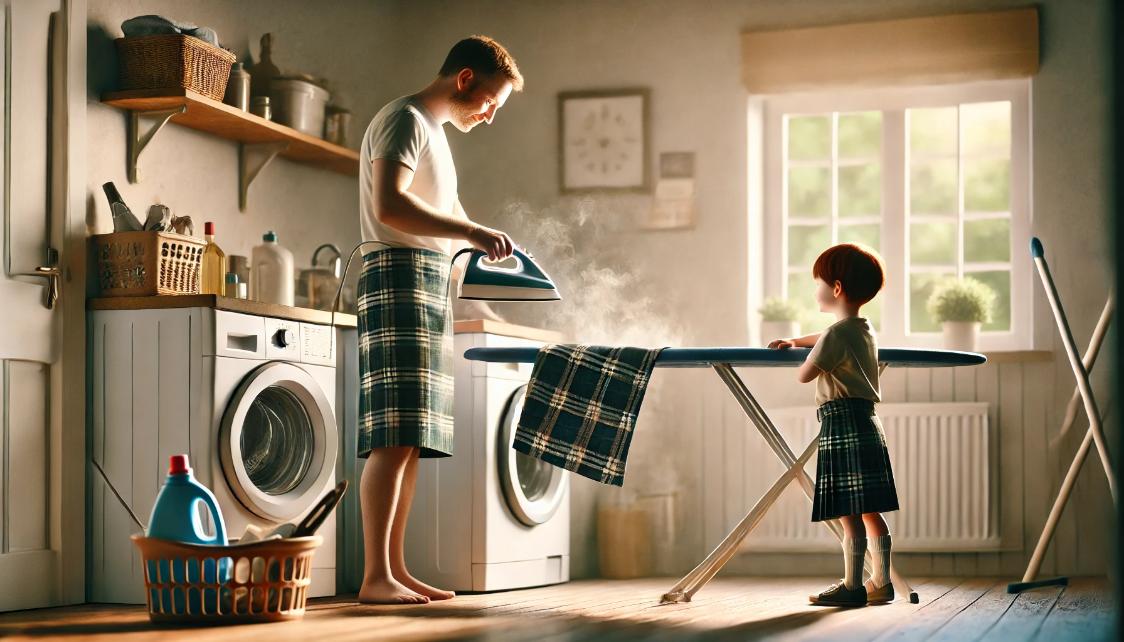Caring for Your Child’s Kilt: Cleaning and Maintenance Tips

Kilts are timeless and stylish clothing, particularly loved for their versatility and cultural significance. Whether worn for a special occasion, like a wedding or celebration, or incorporated into everyday outfits, kilts are a great way to add personality and charm to your child's wardrobe. However, like any other garment, kilts need proper care to ensure they stay in excellent condition for years.
From fabric care to stain removal and even storing your kilts for kids properly, several important aspects of maintenance can help keep this unique garment looking its best. In this blog, we'll explore practical tips for cleaning and caring for your child's kilt, which remains a staple in their wardrobe for many occasions.
1. Understanding the Fabric of Your Child's Kilt
Kilts come in various fabrics, and each fabric requires a different care approach. Knowing what fabric your kid kilts uses helps you choose the correct cleaning and maintenance methods.
Wool Kilts: Traditional wool kilts, often associated with Scottish heritage, are durable, warm, and stylish. However, wool requires delicate care to preserve its shape, color, and softness. Avoid hot water or high heat while cleaning wool, as it can shrink or become misshapen.
Cotton or Synthetic Blends: Many manufacturers make modern kilts from cotton or synthetic blends. These fabrics are typically more durable and easier to clean than wool. They are less likely to shrink and can often withstand machine washing if done carefully.
Tartan Patterns: Kilts often feature intricate tartan patterns, so handling them carefully is essential to avoid fading or bleeding of colors. Always check the care instructions to ensure you follow the proper cleaning methods to maintain the vibrancy of the tartan design.
2. Basic Cleaning Tips for Kilts
Whether your Youth kilts is unique for formal events or a casual, everyday piece, regular cleaning is essential to maintain its appearance. Here are some crucial tips for keeping your child's kilt fresh and clean.
Spot Cleaning: Spot cleaning is quick and effective for minor spills or stains. Use a damp cloth or sponge with a mild detergent to gently blot the stain. Avoid rubbing, as this could damage the fabric or spread the stain further. Consider using a fabric-safe stain remover for tougher stains, but always test it in an inconspicuous area first.
Hand Washing vs. Machine Washing: If the care label allows, you can wash your child's kilt in cold water using a gentle detergent. For wool kilts, hand washing is usually the best option. Fill a sink or basin with lukewarm water and add some wool-safe detergent. Gently agitate the kilt to remove dirt, then rinse thoroughly with cool water. Be sure never to wring out wool garments, as it can cause them to lose shape.
Machine washing may be possible for cotton or synthetic kilts, but always use a gentle cycle and cold water. Place the kilt inside a mesh laundry bag to prevent it from getting tangled or damaged. Avoid fabric softeners, as they can break down the fabric over time.
Avoid Harsh Chemicals: Avoid using bleach or harsh chemicals when cleaning kilts, as they can weaken the fabric and strip the colors. Stick to mild detergents that are gentle on the fibers, especially when dealing with a wool kilt.
3. Drying Your Child's Kilt the Right Way
Drying a kilt properly is just as important as cleaning it. The drying process can significantly affect how the fabric maintains its shape and color.
Air Drying: Always air dry kilts rather than put them in the dryer. High heat can shrink or distort the fabric, especially in wool kilts. Lay the kilt flat on a clean towel to dry, reshaping it as necessary to maintain the pleats. Avoid hanging a kilt by the waistband, as this can cause the fabric to stretch and lose its shape.
Avoid Direct Heat: Don't place the kilt in direct sunlight or near a radiator to dry. Direct heat can cause colors to fade and weaken the fibers, leading to premature wear. Allow the kilt to dry naturally in a well-ventilated area away from heat sources.
4. Pressing and Ironing Your Child's Kilt
A crisp, well-pressed kilt looks sharp and polished, especially for special occasions. However, ironing the kilt correctly is essential to avoid damaging the fabric.
Why Pressing Matters: Pressing your child's kilt helps maintain its pleats and smooth appearance. If your child wears their kilt regularly, it's a good idea to press it occasionally to keep it looking neat. Wool kilts benefit from pressing, as it helps restore their structure.
Ironing Tips: Always check the fabric care label for specific instructions when ironing a kilt. Use a low heat setting on your iron, especially for wool or synthetic blends. Place a pressing cloth (clean cotton) between the iron and the fabric to protect it from direct heat. It will prevent burns, shine marks, or damage to the fibers.
If your kilt has pleats, be careful not to press them flat. Instead, iron the pleats gently to avoid squashing them, and iron in the direction of the pleats to maintain their shape.
5. Storing Your Child's Kilt Properly
Proper storage plays a significant role in prolonging the life of your child's kilt. Storing it correctly prevents wrinkles, maintains the pleats, and protects it from damage.
Hanging vs. Folding: Ideally, kilts should be hung in a cool, dry place. Use a sturdy hanger with a wide bar to prevent the waistband from stretching. Make sure you arrange the pleats appropriately to maintain their crispness. If you prefer folding the kilt, fold it neatly and store it in a breathable garment bag to protect it from dust.
Protecting from Pests: Store your child's kilt in a garment bag or use natural repellents like cedar or lavender sachets to avoid damage from moths or other pests. It is essential for wool kilts, which are more susceptible to pest damage than synthetic materials.
6. Dealing with Stubborn Stains and Odors
Stains or odors are sometimes inevitable, especially for active children who love to play outside. Here are some tips for dealing with tough stains and lingering odors.
Stubborn Stains: If your child's kilt gets stained with something more challenging to remove, like ink or food, don't panic. For wool kilts, gently dab the stain with a wool-safe remover or use mild detergent and water. For cotton or synthetic kilts, you can use a general stain remover. Always test the product on an inconspicuous area before applying it to the stain directly.
Odor Removal: If your child's kilt has developed a smell from frequent wear or outdoor activities, hang it outside to air out or use a fabric refresher that is safe for the fabric. Avoid using too much product, as it can affect the texture of the fabric. For persistent odors, a quick wash might be necessary.
7. Special Considerations for Wool Kilts
Wool kilts require special attention to maintain their structure, softness, and vibrancy. Here are some tips specifically for wool:
Caring for Wool Fabric: Wool is a delicate fabric that requires extra care when cleaning. Always hand wash wool kilts in cool water with a wool-safe detergent. Avoid wringing or twisting the fabric, which can cause it to lose shape. After washing, gently reshape the kilt and lay it flat to dry.
Preventing Shrinkage: Wool is prone to shrinking if exposed to heat or hot water. Always wash wool kilts in cold water and air dry to prevent shrinkage. Never use a tumble dryer, as it can damage the fibers and alter the fit of the kilt.
8. When to Take Your Child's Kilt to a Professional Cleaner
While at-home care is usually sufficient for regular cleaning and maintenance, there are times when it's best to leave the cleaning to the professionals. For example:
- If the kilt has a particularly delicate or intricate design.
- If the kilt is heavily soiled or stained and requires specialized treatment.
- If the kilt comes from a fabric that requires professional dry cleaning, such as some high-end wool blends, take it to a dry cleaner.
A professional cleaner with experience handling kilts can clean the garment without compromising the fabric or structure.
Conclusion: Keeping Your Child's Kilt in Great Condition
Caring for your child's kilt doesn't have to be complicated. With the proper cleaning methods, storage, and occasional pressing, your child's kilt can remain in excellent condition, ready for special occasions and everyday wear. By following these maintenance tips, you can ensure that the kilt will last for years, staying vibrant and comfortable for all the activities your child enjoys.
With some care and attention, a kilt can become a lasting wardrobe staple passed down through generations or worn with pride for many years.


